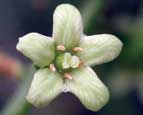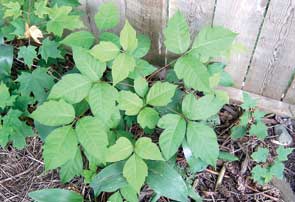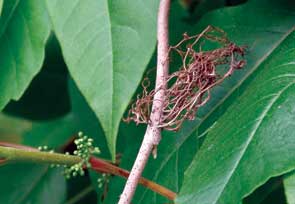Scouting for weeds: poison ivy
Editor’s note: This article is from the archives of the MSU Crop Advisory Team Alerts. Check the label of any pesticide referenced to ensure your use is included.
Poison ivy (Toxicodendron radicans (L.) Ktze.
Family: Anacardiaceae (Cashew family)
Life cycle: Perennial woody vine.
Leaves: Alternate, compound with three shiny leaflets. Leaflet
margins may be smooth, toothed or lobed. The side leaflets occur on very
short stalks; the middle leaflet occurs on a much longer stalk. Leaves
may turn bright red in the fall. Contact with any part of this plant can
cause a reaction in sensitive people.
Stems: Shrubby or climbing, woody vines are supported by aerial roots.
Flowers and fruit: Small, inconspicuous, yellow to green flowers have five petals. Fruit are gray to white berries (drupes).
Reproduction: Seeds, creeping roots and stems, which may root if in contact with the ground.
Control: Mechanical control is generally not recommended due to
the allergenic dermatitis of poison ivy. However, when growing on
desirable plants, carefully cut the woody stems at the soil surface and
treat with an herbicide. Poison ivy can be controlled with herbicides
that contain triclopyr (Brush-B-Gon), 2,4-D, triclopyr plus 2,4-D ester
(Crossbow), glyphosate (Roundup, others) or triclopyr plus glyphosate
(Roundup Poison Ivy Killer). Repeated applications may be necessary.



 Print
Print Email
Email






